AI Research
Could robots really replace human astronauts?


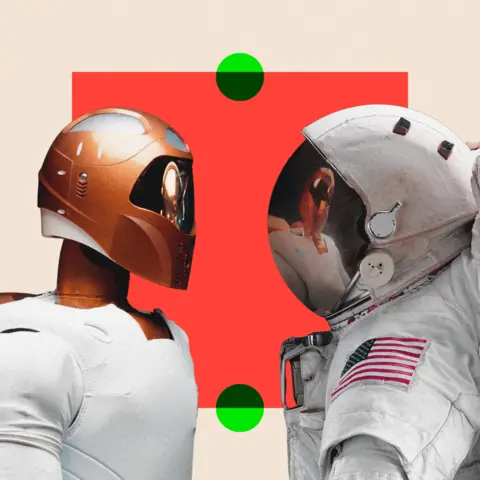 BBC
BBCOn Christmas Eve, an autonomous spacecraft flew past the Sun, closer than any human-made object before it. Swooping through the atmosphere, Nasa’s Parker Solar Probe was on a mission to discover more about the Sun, including how it affects space weather on Earth.
This was a landmark moment for humanity – but one without any human directly involved, as the spacecraft carried out its pre-programmed tasks by itself as it flew past the sun, with no communication with Earth at all.
Robotic probes have been sent across the solar system for the last six decades, reaching destinations impossible for humans. During its 10-day flyby, the Parker Solar Probe experienced temperatures of 1000C.
But the success of these autonomous spacecraft – coupled with the rise of new advanced artificial intelligence – raises the question of what role humans might play in future space exploration.
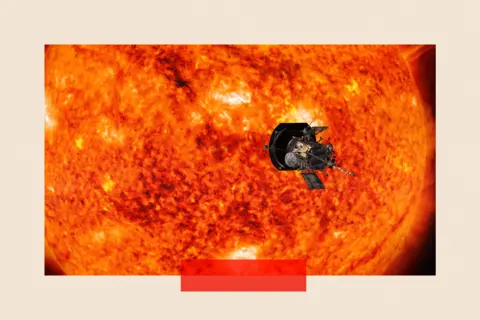 NASA
NASASome scientists question whether human astronauts are going to be needed at all.
“Robots are developing fast, and the case for sending humans is getting weaker all the time,” says Lord Martin Rees, the UK’s Astronomer Royal. “I don’t think any taxpayer’s money should be used to send humans into space.”
He also points to the risk to humans.
“The only case for sending humans [there] is as an adventure, an experience for wealthy people, and that should be funded privately,” he argues.
Andrew Coates, a physicist from University College London, agrees. “For serious space exploration, I much prefer robotics,” he says. “[They] go much further and do more things.”
 NASA
NASAThey are also cheaper than humans, he argues. “And as AI progresses, the robots can be cleverer and cleverer.”
But what does that mean for future generations of budding astronauts – and surely there are certain functions that humans can do in space but which robots, however advanced, never could?
Rovers versus mankind
Robotic spacecraft have visited every planet in the solar system, as well as many asteroids and comets, but humans have only gone to two destinations: Earth’s orbit and the Moon.
In all, about 700 people have been to space, since the earliest in 1961, when Yuri Gagarin from the then-Soviet Union became the first cosmic explorer. Most of those have been into orbit (circling the Earth) or suborbit (short vertical hops into space lasting minutes, on vehicles like the US company Blue Origin’s New Shepard rocket).
“Prestige will always be a reason that we have humans in space,” says Dr Kelly Weinersmith, a biologist at Rice University, Texas and co-author of A City on Mars. “It seems to have been agreed upon as a great way to show that your political system is effective and your people are brilliant.”
But aside from an innate desire to explore, or a sense of prestige, humans also carry out research and experiments in Earth’s orbit, such as on the International Space Station, and use these to advance science.
 NASA
NASARobots can contribute to that scientific research, with the ability to travel to locations inhospitable to humans, where they can use instruments to study and probe the atmospheres and surfaces.
“Humans are more versatile and we get stuff done faster than a robot, but we’re really hard and expensive to keep alive in space,” says Dr Weinersmith.
In her 2024 Booker Prize-winning novel Orbital, author Samantha Harvey puts it more lyrically: “A robot has no need for hydration, nutrients, excretion, sleep… It wants and asks for nothing.”
But there are downsides. Many robots are slow and methodical – for example on Mars, the rovers (remote-controlled motor vehicles) trundle along at barely 0.1mph.
“AI can beat human beings at chess, but does that mean they’ll be able to beat human beings in exploring environments?” asks Dr Ian Crawford, a planetary scientist at the University of London. “I just don’t think we know.”
He does, however, believe that AI algorithms might enable rovers to be “more efficient”.
AI assistants and humanoid robots
Technology can play a part in complementing human space travel by freeing up astronauts from certain tasks to allow them to focus on more important research.
“[AI could be used to] automate tedious tasks,” explains Dr Kiri Wagstaff, a computer and planetary scientist in the US who previously worked at Nasa’s Jet Propulsion Laboratory in California. “On the surface of a planet, humans get tired and lose focus, but machines won’t.”
The challenge is that vast amounts of power are needed to operate systems like large language models (LLM), which can understand and generate human language by processing vast amounts of text data. “We are not at the point of being able to run an LLM on a Mars rover,” says Dr Wagstaff.
“The rovers’ processors run at about a tenth [of the speed] that your smartphone has” – meaning they are unable to cope with the intense demands of running an LLM.
Complex humanoid machines with robotic arms and limbs are another form of technology that could take on basic tasks and functions in space, particularly as they more closely mimic the physical capabilities of humans.
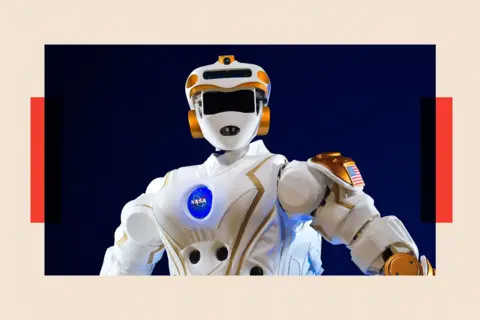 NASA
NASANasa’s Valkyrie robot was built by the Johnson Space Center to compete in a 2013 robotics challenge trial. Weighing 300lb and standing at 6ft2in, it looks not unlike a Star Wars Stormtrooper, but it is one of an increasing number of human-like machines with superhuman abilities.
Long before the Valkyrie was created, Nasa’s Robonaut was the first humanoid robot designed for use in space, taking on tasks that were otherwise performed by humans.
Its specially designed hands meant it could use the same tools as astronauts and carry out complex, delicate tasks like grasping objects or flicking switches, that were too challenging for other robotic systems.
A later model of the Robonaut was flown to the International Space Station on the space shuttle Discovery in 2011, where it helped with maintenance and assembly.
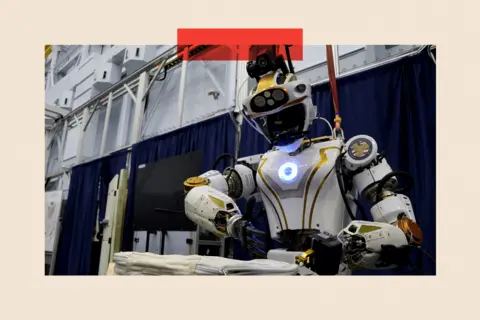 Reuters
Reuters“If we need to change a component or clean a solar panel, we could do that robotically,” says Dr Shaun Azimi, lead of the dexterous robotics team at Nasa’s Johnson Space Center in Texas. “We see robots as a way to secure these habitats when humans aren’t around.”
He argues that robots could be useful, not to replace human explorers but to work alongside them.
Some robots are already working on other planets without humans, sometimes even making decisions on their own. Nasa’s Curiosity rover, for example, is exploring a region called Gale Crater on Mars and autonomously performs some of its science without human input.
“You can direct the rover to take pictures of a scene, look for rocks that might fit science priorities for the mission, and then autonomously fire its laser at that target,” says Dr Wagstaff.
“It can get a reading of a particular rock and send it back to Earth while the humans are still asleep.”
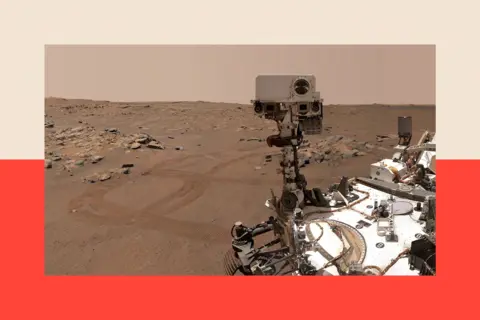 NASA
NASABut the capabilities of rovers like Curiosity are limited by their slow pace. And there is something else they cannot compete with too. That is, humans have the added bonus of inspiring people back on Earth in a way that machines cannot.
“Inspiration is something that is intangible,” argues Prof Coates.
Leroy Chiao, a retired Nasa astronaut who went on three flights to space in the 1990s and 2000s on Nasa’s Space Shuttle and to the International Space Station, agrees. “Humans relate when humans are doing something.
“The general public is excited about robotic missions. But I would expect the first human on Mars to be even bigger than the first Moon landing.”
Life on Mars?
Humans have not travelled further than Earth’s orbit since December 1972, when the last Apollo mission visited the Moon. Nasa is hoping to return humans there this decade with its Artemis programme.
The next crewed mission will see four astronauts fly around the Moon in 2026. A further mission, scheduled for 2027, will see Nasa astronauts land on the Moon’s surface.
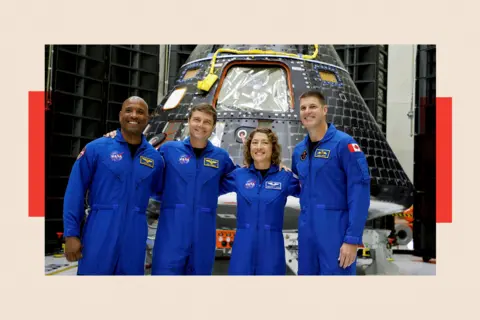 Reuters
ReutersThe Chinese space agency, meanwhile, also wants to send astronauts to the Moon.
Elsewhere Elon Musk, CEO of the US company SpaceX, has his own plans related to space. He has said that his long-term plan is to create a colony on Mars, where humans could land.
His idea is to use Starship, a vast new vehicle that his company is developing, to transport up to 100 people there at a time, with the aim for there to be a million people on Mars in 20 years.
“Musk is arguing we need to move to Mars because that could be a backup for humanity if something catastrophic happens on Earth,” explains Dr Weinersmith. “If you buy that argument, then sending humans into space is necessary.”
However, there are large unknowns about living on Mars, including myriad technical challenges that she says remain unsolved.
“Maybe babies can’t develop in that environment,” she says. “There [are] ethical questions [like this] that we don’t have the answers to.
“I think we should be slowing down.”
Lord Rees has a vision of his own, though, in which human and robotic exploration might merge to the point that humans themselves are part-machine to cope with extreme environments. “I can imagine they will use all of the techniques of genetic modification, cyborg add-ons, and so on, to cope with very hostile environments,” he says.
“We may have a new species that will be happy to live on Mars.”
Until then, however, humans are likely to continue their small steps into the cosmos, on a path long trodden by robotic explorers before them.
Top image credit: NASA
BBC InDepth is the new home on the website and app for the best analysis and expertise from our top journalists. Under a distinctive new brand, we’ll bring you fresh perspectives that challenge assumptions, and deep reporting on the biggest issues to help you make sense of a complex world. And we’ll be showcasing thought-provoking content from across BBC Sounds and iPlayer too. We’re starting small but thinking big, and we want to know what you think – you can send us your feedback by clicking on the button below.
AI Research
‘AI Learning Day’ spotlights smart campus and ecosystem co-creation

When artificial intelligence (AI) can help you retrieve literature, support your research, and even act as a “super assistant”, university education is undergoing a profound transformation.
On 9 September, XJTLU’s Centre for Knowledge and Information (CKI) hosted its third AI Learning Day, themed “AI-Empowered, Ecosystem-Co-created”. The event showcased the latest milestones of the University’s “Education + AI” strategy and offered in-depth discussions on the role of AI in higher education.
In her opening remarks, Professor Qiuling Chao, Vice President of XJTLU, said: “AI offers us an opportunity to rethink education, helping us create a learning environment that is fairer, more efficient and more personalised. I hope today’s event will inspire everyone to explore how AI technologies can be applied in your own practice.”
Professor Qiuling Chao
In his keynote speech, Professor Youmin Xi, Executive President of XJTLU, elaborated on the University’s vision for future universities. He stressed that future universities would evolve into human-AI symbiotic ecosystems, where learning would be centred on project-based co-creation and human-AI collaboration. The role of educators, he noted, would shift from transmitters of knowledge to mentors for both learning and life.

Professor Youmin Xi
At the event, Professor Xi’s digital twin, created by the XJTLU Virtual Engineering Centre in collaboration with the team led by Qilei Sun from the Academy of Artificial Intelligence, delivered Teachers’ Day greetings to all staff.
(Teachers’ Day message from President Xi’s digital twin)
“Education + AI” in diverse scenarios
This event also highlighted four case studies from different areas of the University. Dr Ling Xia from the Global Cultures and Languages Hub suggested that in the AI era, curricula should undergo de-skilling (assigning repetitive tasks to AI), re-skilling, and up-skilling, thereby enabling students to focus on in-depth learning in critical thinking and research methodologies.
Dr Xiangyun Lu from International Business School Suzhou (IBSS) demonstrated how AI teaching assistants and the University’s Junmou AI platform can offer students a customised and highly interactive learning experience, particularly for those facing challenges such as information overload and language barriers.
Dr Juan Li from the School of Science shared the concept of the “AI amplifier” for research. She explained that the “double amplifier” effect works in two stages: AI first amplifies students’ efficiency by automating tasks like literature searches and coding. These empowered students then become the second amplifier, freeing mentors from routine work so they can focus on high-level strategy. This human-AI partnership allows a small research team to achieve the output of a much larger one.
Jing Wang, Deputy Director of the XJTLU Learning Mall, showed how AI agents are already being used to support scheduling, meeting bookings, news updates and other administrative and learning tasks. She also announced that from this semester, all students would have access to the XIPU AI Agent platform.

Students and teachers are having a discussion at one of the booths
AI education system co-created by staff and students
The event’s AI interactive zone also drew significant attention from students and staff. From the Junmou AI platform to the E
-Support chatbot, and from AI-assisted creative design to 3D printing, 10 exhibition booths demonstrated the integration of AI across campus life.
These innovative applications sparked lively discussions and thoughtful reflections among participants. In an interview, Thomas Durham from IBSS noted that, although he had rarely used AI before, the event was highly inspiring and motivated him to explore its use in both professional and personal life. He also shared his perspective on AI’s role in learning, stating: “My expectation for the future of AI in education is that it should help students think critically. My worry is that AI’s convenience and efficiency might make students’ understanding too superficial, since AI does much of the hard work for them. Hopefully, critical thinking will still be preserved.”
Year One student Zifei Xu was particularly inspired by the interdisciplinary collaboration on display at the event, remarking that it offered her a glimpse of a more holistic and future-focused education.
Dr Xin Bi, XJTLU’s Chief Officer of Data and Director of the CKI, noted that, supported by robust digital infrastructure such as the Junmou AI platform, more than 26,000 students and 2,400 staff are already using the University’s AI platforms. XJTLU’s digital transformation is advancing from informatisation and digitisation towards intelligentisation, with AI expected to empower teaching, research and administration, and to help staff and students leap from knowledge to wisdom.

Dr Xin Bi
“Looking ahead, we will continue to advance the deep integration of AI in education, research, administration and services, building a data-driven intelligent operations centre and fostering a sustainable AI learning ecosystem,” said Dr Xin Bi.
By Qinru Liu
Edited by Patricia Pieterse
Translated by Xiangyin Han
AI Research
Vietnam plans to introduce Law on Artificial Intelligence

This information was announced by Minister of Science and Technology Nguyen Manh Hung at a conference organised by the Ho Chi Minh National Academy of Politics in coordination with the Ministry of Public Security, the Ministry of National Defense, and the Central Theoretical Council in Hanoi on September 15.
| Minister of Science and Technology Nguyen Manh Hung. Photo: MST |
At the event, experts, businesses, and managers shared their ideas in two discussion sessions. The first session focused on AI power, risks and control, analysing both positive and negative aspects, affirming the need to exploit potential and control ethics, safety, security, and social risks.
In the second session, they discussed national AI development strategy, from vision to actions, a specific roadmap to make AI a pillar in Vietnam’s socioeconomic development.
They agreed that for AI to truly become a driving force for development, Vietnam needs a comprehensive strategy: data infrastructure, high-quality human resources, a complete legal framework, and a dynamic innovation ecosystem. More importantly, AI must be oriented to serve people, protect human rights, and strengthen national security in the digital age.
According to Minister Hung, Vietnam issued its first AI Strategy in 2021, but AI is a rapidly changing field, so the strategy needed to be updated.
By the end of this year, the country will have an updated version of the National AI Strategy and the AI Law. This is not only a legal framework, but also a declaration of national vision. AI must become the country’s intellectual infrastructure, serving the people, developing sustainably, and enhancing national competitiveness.
Regarding open AI technology, Hung emphasised that Vietnam is committed to developing and mastering digital technology, including AI, based on open standards and open-source code. This is also Vietnam’s strategy to develop and master Vietnamese technology, implementing the “Make in Vietnam” programme.
 |
| Experts, businesses, and managers share their ideas at the conference. Photo: MST |
Regarding creating a domestic AI market, he said that without applications, there will be no market. Without a market, Vietnamese AI enterprises will remain small. Therefore, promoting AI applications in enterprises, in state agencies and key areas is the fastest way to develop AI and create Vietnamese AI enterprises.
“The government will spend more on AI, the Natif Technology Innovation Fund of the Ministry of Science and Technology will spend at least 40 per cent to support AI applications, issue vouchers for small and medium-sized enterprises using Vietnamese AI. The domestic market is the cradle to create Vietnamese AI enterprises,” he noted.
In terms of policy and institutions, he added that Vietnam will issue a national AI ethics code that is in line with international standards but suitable for Vietnamese practice, and at the same time develop an AI Law and an AI strategy with core principles including risk-based management, transparency and accountability, putting people at the center, encouraging domestic AI development, AI autonomy, using AI as a driving force for rapid and sustainable growth, and protecting digital sovereignty based on three pillars: data, infrastructure, and AI technology.
According to the MST, Vietnam’s AI development will have to be based on four important pillars: transparent institutions, modern infrastructure, high-quality human resources, and humane culture.
Time for Vietnam to make breakthroughs
Speaking at the workshop, Luong Tam Quang, Minister of Public Security, said that AI is considered one of the key technologies, a factor that can lead to changes in the global order.
 |
| Luong Tam Quang, Minister of Public Security. Photo: MST |
He added that with the ability to promote economic growth, optimise production, improve healthcare, innovate education, and enhance social governance capacity, AI helps countries save costs, increase efficiency, and expand knowledge. It is also a resource, and a driving force to affirm the country’s position in the digital age.
According to Minister Quang, Vietnam’s potential for AI development is huge, and is expected to contribute about $79.3 billion, equivalent to 12 per cent of Vietnam’s GDP in 2030 if widely applied. Under the leadership of the Party, legal regulations for the development of AI have gradually taken shape.
Prof. Dr. Nguyen Xuan Thang, director of the Ho Chi Minh National Academy of Politics, and chairman of the Central Theoretical Council, said that AI is becoming an indispensable part in the process of establishing a new growth model and the operation, governance, and management of the country’s society and economy.
 |
| Prof. Dr. Nguyen Xuan Thang, director of the Ho Chi Minh National Academy of Politics, and chairman of the Central Theoretical Council. Photo: MST |
However, to turn potential into reality, it requires the support of the entire ecosystem, from national strategies and policies to implementation in businesses, institutes, schools, and the community.
“AI cannot develop sustainably without responsibility, ethics, and a clear humanistic orientation. Technology is the tool, while humans are the goal and the deciding factor, because even if it possesses unlimited power as many people believe, AI is still a product created by humans,” Thang emphasised.
 |
FPT University and Dream Lab harness AI to cultivate startups
FPT University and Dream Lab on July 31 signed a MoU to launch a groundbreaking initiative aimed at building Vietnam’s most dynamic startup and entrepreneurial ecosystem for students. |
 |
Citi launches AI tools for employees in Vietnam
Citi has expanded the rollout of its generative AI tools to employees across key Asian markets, marking a significant step towards enhancing productivity and innovation. |
 |
AI boom drives data center surge in Southeast Asia
AI is fueling an unprecedented surge in data center demand that Southeast Asia is not yet ready to meet. |
AI Research
Philippine businesses slow to adopt AI, study finds – People Matters Global

Philippine businesses slow to adopt AI, study finds People Matters Global
Source link
-

 Business3 weeks ago
Business3 weeks agoThe Guardian view on Trump and the Fed: independence is no substitute for accountability | Editorial
-
Tools & Platforms1 month ago
Building Trust in Military AI Starts with Opening the Black Box – War on the Rocks
-

 Ethics & Policy2 months ago
Ethics & Policy2 months agoSDAIA Supports Saudi Arabia’s Leadership in Shaping Global AI Ethics, Policy, and Research – وكالة الأنباء السعودية
-

 Events & Conferences4 months ago
Events & Conferences4 months agoJourney to 1000 models: Scaling Instagram’s recommendation system
-

 Jobs & Careers3 months ago
Jobs & Careers3 months agoMumbai-based Perplexity Alternative Has 60k+ Users Without Funding
-

 Podcasts & Talks2 months ago
Podcasts & Talks2 months agoHappy 4th of July! 🎆 Made with Veo 3 in Gemini
-

 Education2 months ago
Education2 months agoMacron says UK and France have duty to tackle illegal migration ‘with humanity, solidarity and firmness’ – UK politics live | Politics
-

 Education3 months ago
Education3 months agoVEX Robotics launches AI-powered classroom robotics system
-

 Podcasts & Talks2 months ago
Podcasts & Talks2 months agoOpenAI 🤝 @teamganassi
-

 Funding & Business3 months ago
Funding & Business3 months agoKayak and Expedia race to build AI travel agents that turn social posts into itineraries


